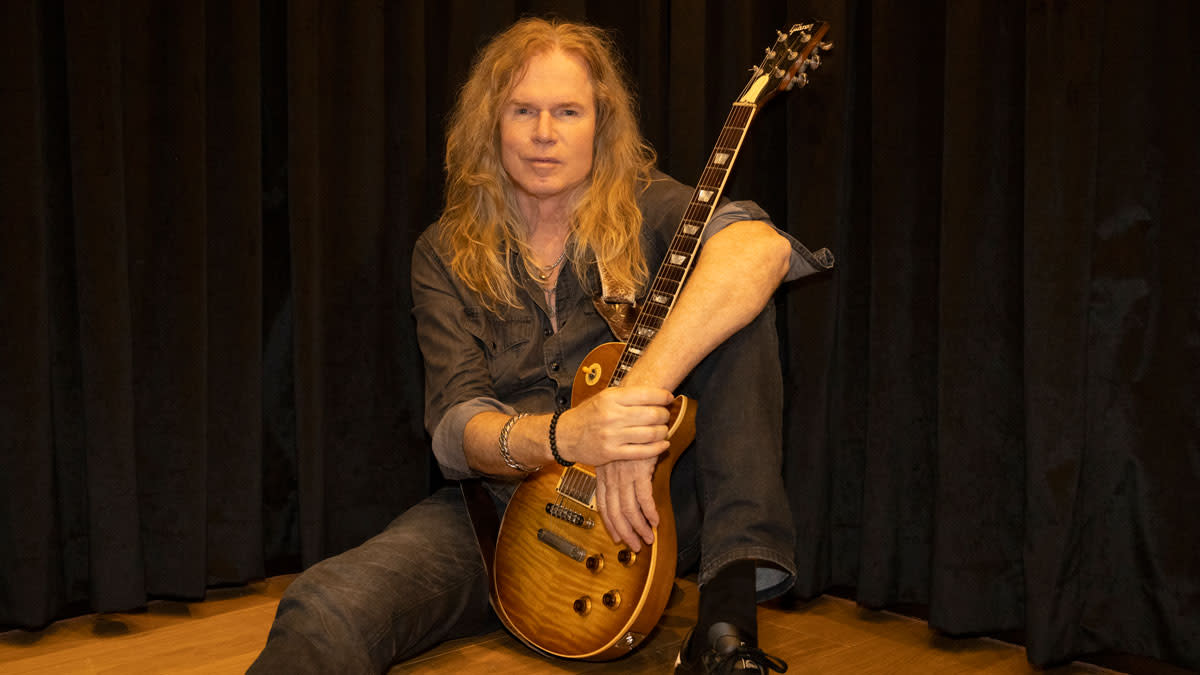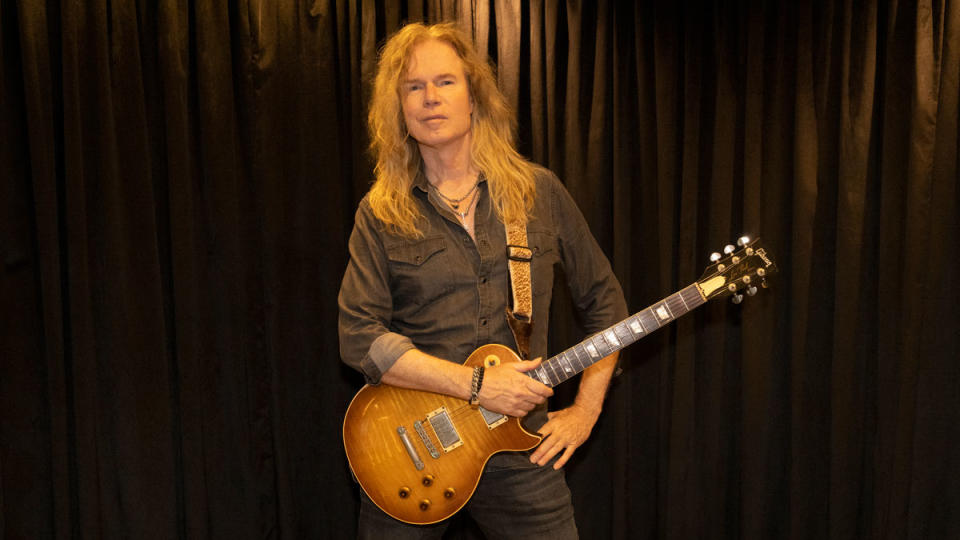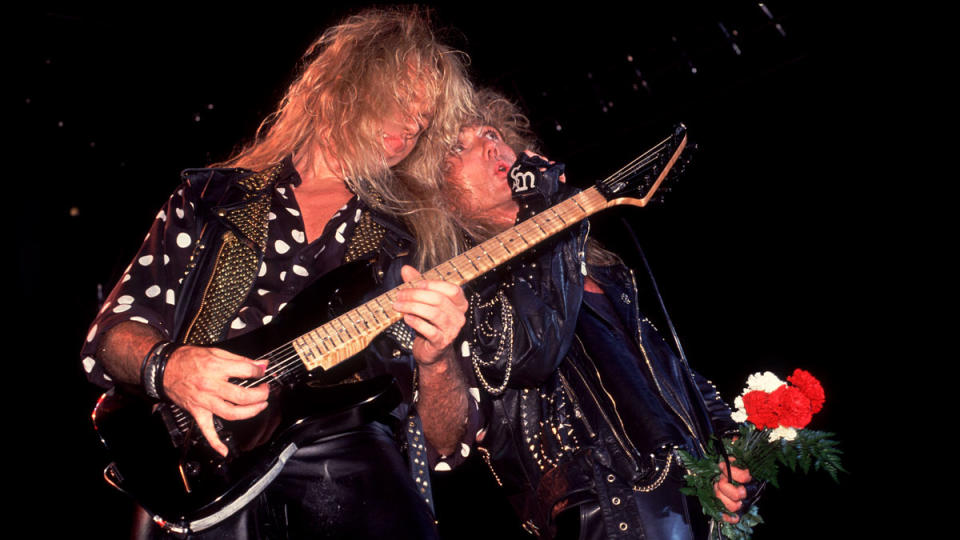“Rhythm playing is the backbone of what a guitar player is trying to say – and it’s become deeply undervalued today”: Adrian Vandenberg is back with one of this year’s biggest rock guitar albums – where melody and rhythm are king

- Oops!Something went wrong.Please try again later.
- Oops!Something went wrong.Please try again later.
- Oops!Something went wrong.Please try again later.
While he's long recorded under the moniker of his namesake band, Adrian Vandenberg may be best known for his time with Whitesnake in the late-'80s and into the '90s.
And while he's no longer a member of Whitesnake – and back at it again with Vandenberg in support of the band's latest record, Sin – he holds fond memories of his time alongside David Coverdale.
"The way I ended up in Whitesnake was unexpected," Vandenberg tells Guitar World. "I had parted ways with Vandenberg's singer, and while I was looking for another singer, I got a call from John Kolodner, the A&R manager for Geffen at the time to discuss the new contract for Vandenberg. He didn't like the idea of a completely new lineup, so he suggested that I move away from it and join David [Coverdale] in Whitesnake. And David had already asked me like three times since '82 to join, so I knew he wanted me."
He continues, "When I joined, I knew I wouldn't be able to equal what John [Sykes] had done, but David immediately asked me to devise a new rhythm arrangement for Here I Go Again. What John had done was what was described to me as a 'metal version of country and western music'. So, I came up with some rhythm parts, and I recorded the solo in around 10 minutes, and then that arpeggio rhythm part in the second verse after the first chorus through a Rockman. The whole thing was done very quickly; I had no idea it would be huge."
With the solo for Here I Go Again in the can and John Sykes out of the picture, Vandenberg hit the road with the mighty 'Snake. And not long after, along with Coverdale, Vandenberg began writing the music for what would become 1990's Slip of the Tongue.
Sadly, a debilitating wrist injury would keep Vandenberg out of the studio, leading to Coverdale calling in Steve Vai to cover Vandenberg's parts. "It took me a while to come to terms with it," Vandenberg admits. "I was a big admirer of Steve, but I had a vision of how I wanted those songs to sound: I wanted big rhythm guitars, melodic, and bluesy licks."
But once on tour, Vandenberg had no choice but to learn what Vai had done. He recalls, "It was one of the most challenging things I'd ever done, and it took me a few weeks to start appreciating Steve's work. I had to overcome my frustration about not being able to play the songs as I'd hoped, but once I overcame my frustration and became close with Steve, I came to love how they turned out."
In the years since, Vandenberg has continued and, most importantly, found ways to overcome the wrist issues that stripped him of his ability to play as he once did. What's more, his return to the studio with Vandenberg in 2020 by way of Vandenberg's first record since the '80s, 2020, was a sterling affair.
I definitely regret that the lineup with Steve and I didn't get to continue
Moreover, Vandenberg's latest offering, Sin, is as slick-toned as anything he has conjured in his long career. And so, when Vandenberg says that he's "as proud of Sin as anything I've ever done," he means it.
Vibrant as ever, and with Vandenberg's bright future, he "has few regrets". But there, there are a few – namely, that Whitesnake's Slip of the Tongue-era band didn't get to do more.
"I definitely regret that the lineup with Steve and I didn't get to continue," Vandenberg laments. "But grunge came up, and I've always been the kind of guy who sticks to his guns and does what he does best. So, if I could go back, I would have chosen to stay together and make at least one more album. I wish we had stuck to our guns, stayed together, and gotten back in the saddle like good cowboys [laughs]."
In support of Sin, Adrian Vandenberg dialed in with Guitar World to dig into his modern-day approach, the importance of quality rhythm playing, the status of rock guitar as we know it, and the return of his well-loved '80s shred machine, the Peavy Vandenberg.
How did you approach Sin from a guitar perspective?
"I wanted to turn it up a notch compared to the last one. Because when I looked at the early Vandenberg albums, I realized that after being in the business for as long as I have, the feeling of mailing it in could start to set it. I didn't want that. I didn't want to go in the direction of going softer or acoustic; I wanted to go back in the other direction and get harder, louder, and faster. So, that led me to search for ways to add more gravel to my guitar sounds and be a bit more expressive."
I'd assume it's just a matter of freeing your mind, not overthinking, and going for it, right?
"Exactly. The big thing I've noticed with this generation is that there are a lot more technical guitar players, which led me to want to go in this direction even more. I'm probably already known as a guy who tends to go for the right note at the right time rather than being over the top. Finding just the right amount of expression is essential to what I do, and that comes from many of my heroes being guys like Brian May, Leslie West, and even a guy like Eddie Van Halen, all people who were very fluid and super-melodic. So, being intentional with melody and not focusing on speed is integral to what I try to do."
While many focus on your lead playing, your rhythm approach on Sin is exceptional.
"Well, thank you very much. I'm glad you noticed that, because I put a lot of thought into it. I know that a lot of guitar players will go for big solos, and the audience eats that up, but guitar playing is so much more than that. Rhythm playing is the backbone of whatever a guitar player is trying to say, and I genuinely feel that it's become deeply undervalued today.
"There are not many strong rhythm players out there today; everyone is so technical and, like I said before, going for the big solo. You've got a lot of very talented players out there who can play with speed all day, but rhythm playing is lost on too many of them. To me, strong rhythm playing is essential to getting some excitement going within a song."

A big push out there says, 'Rock guitar is back.' Do you agree with that?
"I look at it the same way I always have, and that's from a very realistic standpoint, meaning that aside from the '80s, when rock guitar music was on MTV all the time, it's never really been at the forefront of people's minds. Rock guitar music will never be like pop music in the United States or anywhere else.
"Sure, each city has a few rock stations, but it's not what sells in the greatest numbers. And even when rock guitar music was popular, you had a lot of solos and stuff that, in my opinion, was cringeworthy. So, I've noticed that rock guitar music has been out of focus since around 2000, and the crowd that consumes a lot of it is still older."
Nuno Bettencourt's Rise solo seemed to stir up some interest in guitar music, though, right?
"What Nuno did was incredible and was a very brave thing to do. He's got this mind-blowing solo on Rise, and everybody who loves rock music and loves rock guitar was talking about it and shit. But that's what Nuno does; he's amazing, and his solo definitely shows that. But the thing is that what Nuno did there isn't appreciated by 15-year-olds because they don't even know it's there.
"And if you look at the last Vandenberg tour we did, that was reflected in the people who attended the shows. But there is a small percentage of young people who find this music, and it's usually through YouTube or something like that. So, I think guitar rock is alive, but it's going to take curious people to keep it that way."
Your tone on Sin is very full and present. How did you achieve it?
"My tone goes back to my days in Whitesnake, where I couldn't play on Slip of the Tongue because of my wrist injury. I wrote these songs with David, and he had to bring Steve to play them. And as a player of his caliber does, he put his stamp on them, but he did so in a style different from what I would have done.
"When I started playing again, I never regained my attack before the injury, but I wanted to play those songs and beyond. So, eventually, I worked out a different technique where I used the nail of my right index finger as a pick. And I'm lucky because I'm blessed with thick nails that are so sharp I can open up a cardboard box from Amazon [laughs]. But my tone comes from finding a new way to play after that wrist injury."
Would you say that having to overcome that injury has, in some ways, made you a more intelligent player?
"I think so, because anyone who has followed my career knows I'm known for melodic solos, and the injury forced me to lean into that. And that's good because when I joined Whitesnake, I probably got a little carried away while playing the amazing guitar parts John Sykes wrote for the '87 Whitesnake album. I remember thinking, 'Man, I'm gonna need to speed up and play harder,' and I did that when we toured. But the injury forced me to focus on my strengths and not allow myself to get carried away in a direction I don't feel I belong in anyway."
As I understand it, the Peavey Vandenberg is returning to the production line. Did you use that on Sin?
"Yeah, I did; I used it on two or three tracks. I can't remember which ones, but it's definitely on there. I had a few guitars with me in the studio, like my Les Paul that I bought in 1980, and I used the purple Peavey Vandenberg that I often played when I toured with Whitesnake in 1997. It sounds good and pairs so well with my Mesa/Boogie amps."

What led to the return of the Peavey model?
"By the time Whitesnake fell apart in 1998, I had been with the band since '86, so that's like 12 years. I had accumulated a serious collection of beefy guitars, including a bunch of Peavey stuff. At the time, I said, 'This stuff is never going to be classic,' and I went back to Holland and only brought four or five of my guitars with me. I didn't want to import all that stuff, so I ended up letting them go. I had no idea the Peavey stuff would become classic and didn't think much of it.
"But as the years passed, people kept asking me if I had any Peavey Vandenberg guitars and if I'd part with them. And since I had a few, I never bothered to answer. And then Facebook groups started popping up in tribute to the guitar, and I saw all these fans. So, eventually, Peavey approached me about bringing it back around a year ago; I said, 'Yes,' and we started working on it. That guitar has taken on a life of its own, which I certainly never expected."
Will the new Peavey Vandenberg models have the same specs as the old?
"The shape is the same, but there will be a few pickup options. We've also got a Floyd Rose on there now. But as far as pickups, we're doing Seymour Duncan pickups in a few different varieties. That aside, it's a striped maple top, on a mahogany body, with the rest essentially being the same.
"I've only seen a couple of prototypes, but the craftsmanship is absolutely amazing. So, I'm very excited to get them back out there to the fans who want them. Like I said, I never expected them to become classic guitars or take on the life that they did. But I'm honored that it's happened that way, and I'm glad they'll be back in the hands of the people who have been wanting them."
SIN is out on August 25 via Mascot Records/Mascot Label Group.

